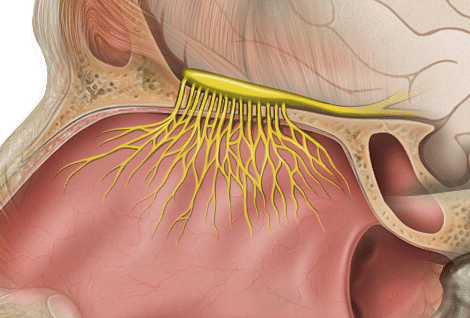Sticks in the nose: A punishment in ancient Egypt? Apparently, in ancient Egypt, damaging a certain brain gland by sticking a stick into the nose was a punishment method. But someone had a lot of imagination!
+++A fact check on a topic that we already covered in December 2020, but will take it up again because this is being shared again and again on social media+++
In various pictures there is the claim that the destruction of the so-called " heatoencephalitis gland ", apparently by means of a stick through the nose, was a punishment in ancient Egypt that very often led to death.

Let's take a look at the full claim before diving into the details.
The claim
“In Egypt, damaging the heatoencephalitis gland was a punishment which very often led to death in the years that followed. If this barrier, which is a thin layer of cells, is damaged or broken, bacteria, viruses and other pathogens can migrate directly into the brain and damage it. The damage cannot be repaired and remains. Now the mainstream media is denying that this happened during a Covid-19 test, but there are now more and more cases where brain fluid comes out of the nose immediately after the test and also many cases where meningitis suddenly spread weeks later . This does not fit with the statements of bought doctors or the censored network. This nasal swab, which some of you have already experienced, only hurts so much because exactly these cells, this protective barrier, is broken through, intentionally.”
The pictures
Let’s start with the visual “evidence.”
Here we have a tiny picture of an Egyptian drawing in which someone appears to be getting a long stick up their nose. But let's just look at the image section in higher resolution:

The image can be found, for example, in various articles ( e.g. HERE ) or on GettyImages ( see HERE ). It shows an ophthalmologist treating a patient.
Let's come to the second picture, which is supposed to show the ominous barrier that is supposedly injured or broken through by the stick.
Here too, let's take a closer look:

In the picture you can see the bulbus olfactorius (olfactory bulb) and the tractus olfactorius (in yellow). As you can clearly see, the olfactory tract runs through the skull.
So if you want to break through the top of your skull with a cotton swab, you would have to use brutal force to ram it into your nose - this is not possible with a swab.
“But there was a case!”
Correct. There was a case.
Not cases. No plural. A woman had cerebrospinal fluid leaking through her nose after the swab. But she was also a medical special case.
The woman had previously had a so-called encephalocele , i.e. a gap in the skull. Parts of the brain can leak out through such a gap. The swab did not cause the crack in the skull as it was already there.
However, the smear may have had a negative impact on the crack. Furthermore, we are dealing with a case that is unique in the world and is unlikely to be replicable in people without encephalocele.
We have published a detailed article on this case . Furthermore, there are no known cases; the claim that there are more and more cases is simply made up.
The “heatoencephalitis gland”
Apparently that gland is injured or ruptured during a smear test. We already described above that that gland is not located there at all. But where do we find them?
Good question! There are two glands in the brain:
- the epiphysis (pineal gland)
- the pituitary gland (pituitary gland)
A heatoencephalitis gland is nowhere to be found, so let's just break the word apart:
- Encephalus = brain
- Encephalitis = inflammation of the brain
- Heato = ???
There is absolutely nothing, not an article, not an entry, in any scientific or medical database, anything about a heatoencephalitis gland .
Even if we remove the unknown prefix “Heato,” the name makes no sense at all: An encephalitis?
Summary
The text and the pictures are nonsense from start to finish:
the Egyptian picture shows an eye treatment, the nose picture shows the olfactory bulb and the top of the skull (as in “thin layer of cells”), the alleged heatoencephalitis gland doesn't even exist, the name alone doesn't give a clue Sense.
Article image: Shutterstock / By Life science
Notes:
1) This content reflects the current state of affairs at the time of publication. The reproduction of individual images, screenshots, embeds or video sequences serves to discuss the topic. 2) Individual contributions were created through the use of machine assistance and were carefully checked by the Mimikama editorial team before publication. ( Reason )

